If you are not familiar with a particular phylum, just click on the name for a brief description and a picture. When you are ready to complete the characteristics summary table in your lab manual click on the ‘Table’ link.
Porifera
Porifera: (5,500 species)
A phylum of simple, sessile, aquatic filter feeding animals called sponges. These multicellular organisms lack true tissues, and are comprised of several types of cells that are functionally independent of one another. Generally speaking, sponges have no pattern of symmetry, i.e. they are asymmetrical. They reproduce asexually (by buds or gemmules) or by sexual reproduction resulting in the formation of free swimming ciliated larvae.
Note: Based on recent molecular data the phylum Porifera is thought to be monophyletic, however some studies suggest that sponges are paraphyletic in that it includes a common ancestor and some, but not all, of its descendants.
|

Reece, J. B., & Campbell, N. A. (2011). Campbell Biology. Boston, Benjamin Cummings / Pearson Education.
|
Cnidaria
Cnidaria: (10,000 species)
Although the freshwater hydra is a much-studied representative, it is not typical of the class as most members are:
- marine
- colonial
- produce two body forms – the sessile polyp (like the hydra) and the free-floating medusa (which disperses the species).
The phylum Cnidaria includes corals, jellies and hydras. These animals share a distinctive body plan that includes a gastrovascular cavity with a single opening that serves as both mouth and anus. They are diploblastic animals: two layers of cells – ectoderm and endoderm – with a jellylike mesoglea between them. The cnidarians are characterised by specialised cells called cnidocytes which function in defense and prey capture. Sexual reproduction produces a free-swimming, ciliated larva called a planula.
|
 Reece, J. B., & Campbell, N. A. (2011). Campbell Biology. Boston, Benjamin Cummings / Pearson Education Reece, J. B., & Campbell, N. A. (2011). Campbell Biology. Boston, Benjamin Cummings / Pearson Education |
Platyhelminthes
Platyhelminthes (20,000 species)
Includes tapeworms, flukes and planarians. These animals are bilaterally symmetrical and triploblastic (comprised of three fundamental cell layers). Flatworms have no body cavity other than the gut (and the smallest free-living forms may even lack that!) and lack an anus; the same pharyngeal opening both takes in food and expels waste. Because of the lack of any other body cavity, in larger flatworms the gut is often very highly branched in order to transport food to all parts of the body. The lack of a cavity also constrains flatworms to be flat; they must respire by diffusion, and no cell can be too far from the outside, making a flattened shape necessary.
|
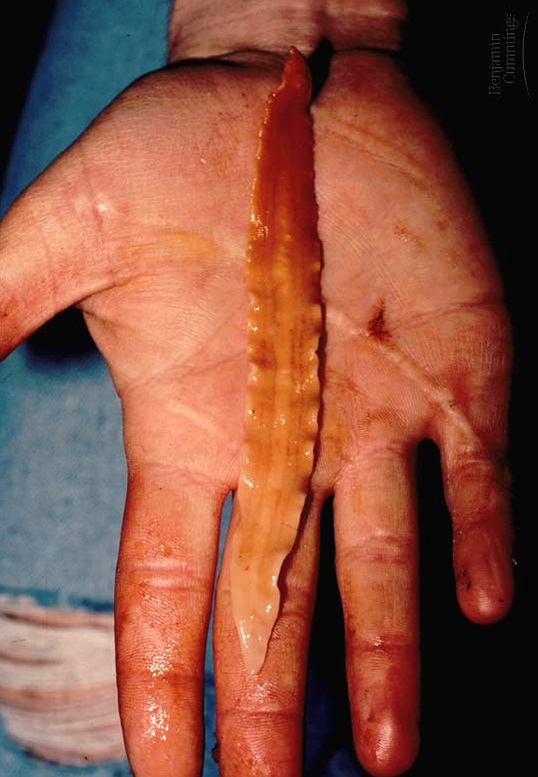 Reece, J. B., & Campbell, N. A. (2011). Campbell Biology. Boston, Benjamin Cummings / Pearson Education. Reece, J. B., & Campbell, N. A. (2011). Campbell Biology. Boston, Benjamin Cummings / Pearson Education. |
Nematoda
Nematoda: (25,000 species)
The most distinctive feature of round worms is a touch cuticle that coats the body. They are a pseudocoelomate animal as they have a body cavity which is lined by mesoderm and endoderm and they have a one-way digestive tract which runs from the mouth to the anus. Most nematodes are free-living and found in soil where they are important decomposers. However, some are parasitic, and include:
- hookworms
- pinworms
- ascaris
- and many parasites of commercially important plants like strawberries and oranges.
Most nematodes are small, although one that parasitises whales reaches 10 metres in length!
|
 Reece, J. B., & Campbell, N. A. (2011). Campbell Biology. Boston, Benjamin Cummings / Pearson Education. Reece, J. B., & Campbell, N. A. (2011). Campbell Biology. Boston, Benjamin Cummings / Pearson Education. |
Arthropoda
Arthropoda: (1,000,000+ species)
Includes the vast majority of known animal species including insects, crustaceans, and arachnids. All arthropods have a segmented exoskeleton made from chitin and jointed appendages. They also possess an open circulatory system where the blood is not confined to vessels. They are known to live in every possible habitat: fresh water, salt water, soil, even in the most forbidding regions of Antarctica and high mountains.
|
 Reece, J. B., & Campbell, N. A. (2011). Campbell Biology. Boston, Benjamin Cummings / Pearson Education. Reece, J. B., & Campbell, N. A. (2011). Campbell Biology. Boston, Benjamin Cummings / Pearson Education. |
Mollusca
Mollusca: (93,000 species)
Includes snails, clams, squids and octopuses. Despite their apparent differences, all molluscs have a similar body plan. Molluscs are coelomates, and their bodies have three main parts: a muscular foot, a visceral mass (containing most of the internal organs), and a mantle, which is a fold of tissue that drapes over the visceral mass and secretes a shell (if one is present). Most molluscs have an open circulatory system where the organs are bathed directly in hemolymph.
|
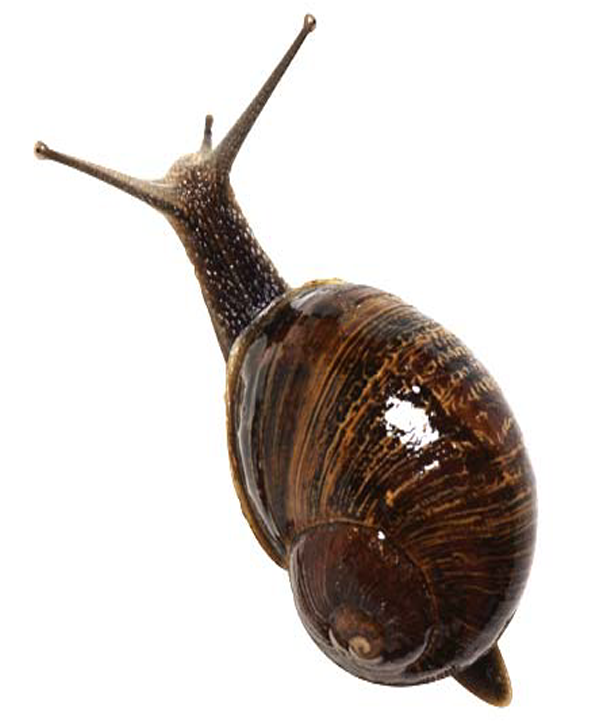 Reece, J. B., & Campbell, N. A. (2011). Campbell Biology. Boston, Benjamin Cummings / Pearson Education. Reece, J. B., & Campbell, N. A. (2011). Campbell Biology. Boston, Benjamin Cummings / Pearson Education. |
Annelida
Annelida: (16,500 species)
Annelida means ‘little rings’ referring to the annelid body’s resemblance to a series of fused rings. The phylum encompasses a large number of marine and freshwater species including leeches and earthworms. Annelids have blood which is confined to blood vessels (so they have a closed circulatory system), they lack try respiratory organs (they ‘breathe’ through their skin), and they are also coelomates.
|
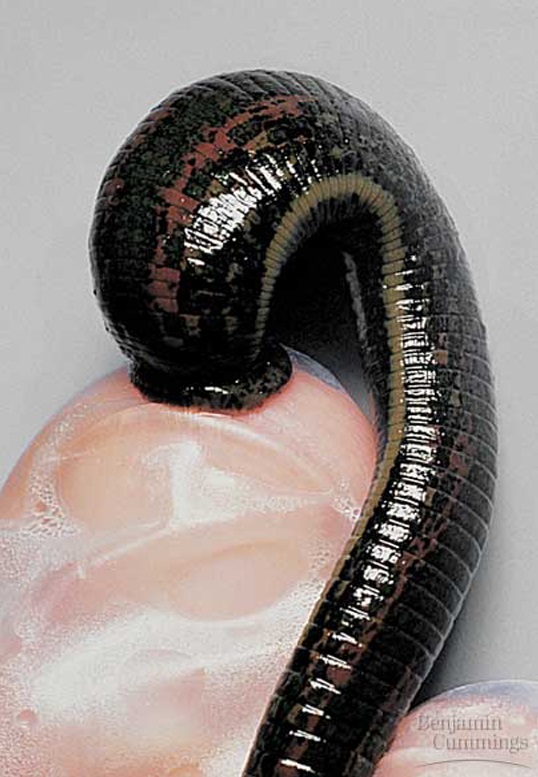 Reece, J. B., & Campbell, N. A. (2011). Campbell Biology. Boston, Benjamin Cummings / Pearson Education. Reece, J. B., & Campbell, N. A. (2011). Campbell Biology. Boston, Benjamin Cummings / Pearson Education. |
Echinodermata
Echinodermata: (7,000 species)
Includes sand dollars, sea stars and sea urchins. These aquatic animals move and feed by using a network of internal canals (the water vascular system) in the coelom that then pumps water to the tube feet. They have an endoskeleton made up of hard calcerous plates which is then covered by a thin epidermis. The internal and external parts of most adult echinoderms radiate from the centre, often as five spokes. However, echinoderm larvae have bilateral symmetry. Like the chordates, echinoderms are deuterostomes.
|
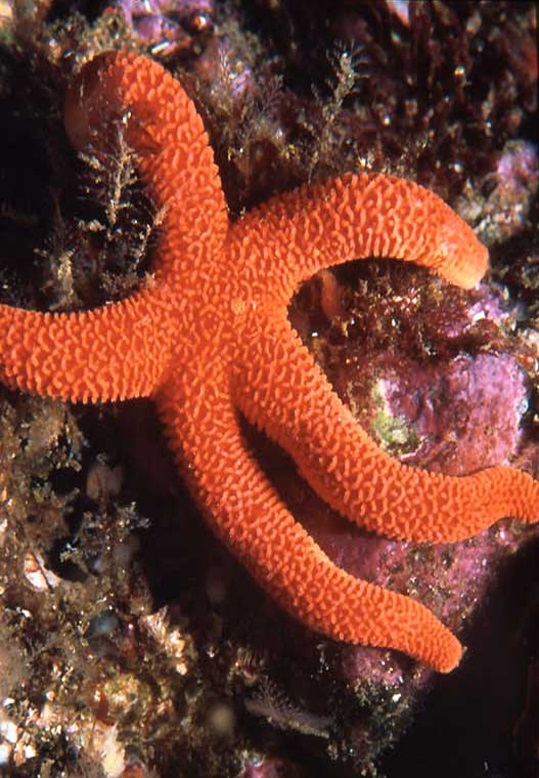 Reece, J. B., & Campbell, N. A. (2011). Campbell Biology. Boston, Benjamin Cummings / Pearson Education. Reece, J. B., & Campbell, N. A. (2011). Campbell Biology. Boston, Benjamin Cummings / Pearson Education. |
Chordata
Chordata (52,000 species)
Vertebrates are a subphylum of the phylum Chordata. All chordates share a set of derived characters, (notochord, dorsal hollow nerve chord, pharyngeal slits, and a muscular post-anal tail) though many species possess some of these traits only during embryonic development. Like the echinoderms, chordates are deuterostomes.
The chordate phylum includes vertebrates, hagfish, tunicates, and the lancelets. The picture is a hagfish, a marine chordate of the class Myxini.
|
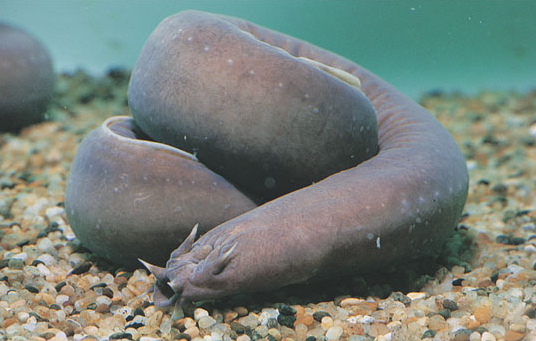 Reece, J. B., & Campbell, N. A. (2011). Campbell Biology. Boston, Benjamin Cummings / Pearson Education. Reece, J. B., & Campbell, N. A. (2011). Campbell Biology. Boston, Benjamin Cummings / Pearson Education. |